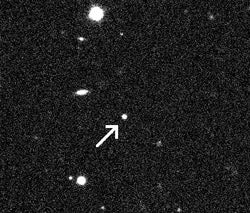Astronomers at the Harvard-Smithsonian Center for Astrophysics (CfA) announced the discovery of the first confirmed case of a star leaving the Milky Way. The star, cataloged as SDSS J090745.0+24507, lies within the boundaries of the constellation Hydra the Water Snake, a little less than 2° west of the star Theta (θ) Hydrae. The astronomers used the MMT Observatory in Amado, Arizona, to make this observation.
“We have never before seen a star moving fast enough to completely escape the confines of our galaxy,” says co-discoverer Warren Brown (CfA). “We’re tempted to call it the ‘outcast star’ because it was forcefully tossed from its home.”
The star’s high speed is only one clue to its origin. Another is the path it’s taking, almost directly away from the galactic center. Its composition provides another clue — many elements heavier than hydrogen and helium exist in this star. This indicates SDSS J090745.0+24507 came from a star-forming region like that in the Milky Way’s center. Finally, if the star originated near our galaxy’s core, less than 80 million years were needed for the star to reach its current location. This figure is consistent with the star’s estimated age.
The star’s high speed probably resulted from a close passage with the Milky Way’s central black hole. Such a gravitational encounter would increase the star’s speed and send it away from the galaxy’s core like a lure cast from the end of a fisherman’s line. “Only the powerful gravity of a very massive black hole could propel a star with enough force to exit our galaxy,” explains Brown.










